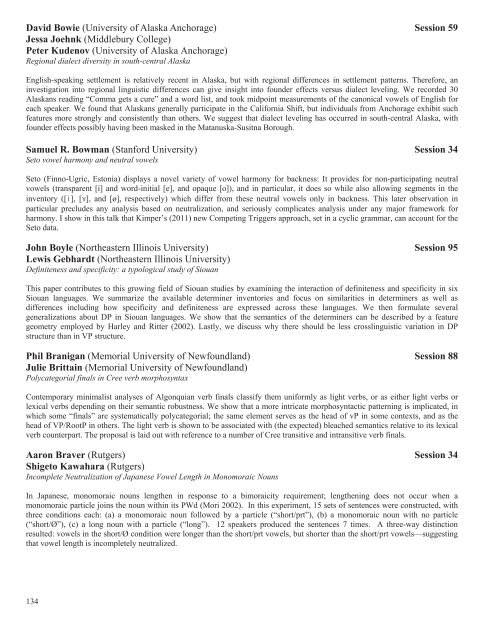here - Linguistic Society of America
here - Linguistic Society of America
here - Linguistic Society of America
Create successful ePaper yourself
Turn your PDF publications into a flip-book with our unique Google optimized e-Paper software.
David Bowie (University <strong>of</strong> Alaska Anchorage) Session 59Jessa Joehnk (Middlebury College)Peter Kudenov (University <strong>of</strong> Alaska Anchorage)Regional dialect diversity in south-central AlaskaEnglish-speaking settlement is relatively recent in Alaska, but with regional differences in settlement patterns. T<strong>here</strong>fore, aninvestigation into regional linguistic differences can give insight into founder effects versus dialect leveling. We recorded 30Alaskans reading “Comma gets a cure” and a word list, and took midpoint measurements <strong>of</strong> the canonical vowels <strong>of</strong> English foreach speaker. We found that Alaskans generally participate in the California Shift, but individuals from Anchorage exhibit suchfeatures more strongly and consistently than others. We suggest that dialect leveling has occurred in south-central Alaska, withfounder effects possibly having been masked in the Matanuska-Susitna Borough.Samuel R. Bowman (Stanford University) Session 34Seto vowel harmony and neutral vowelsSeto (Finno-Ugric, Estonia) displays a novel variety <strong>of</strong> vowel harmony for backness: It provides for non-participating neutralvowels (transparent [i] and word-initial [e], and opaque [o]), and in particular, it does so while also allowing segments in theinventory ([ɨ], [ɤ], and [ø], respectively) which differ from these neutral vowels only in backness. This later observation inparticular precludes any analysis based on neutralization, and seriously complicates analysis under any major framework forharmony. I show in this talk that Kimper’s (2011) new Competing Triggers approach, set in a cyclic grammar, can account for theSeto data.John Boyle (Northeastern Illinois University) Session 95Lewis Gebhardt (Northeastern Illinois University)Definiteness and specificity: a typological study <strong>of</strong> SiouanThis paper contributes to this growing field <strong>of</strong> Siouan studies by examining the interaction <strong>of</strong> definiteness and specificity in sixSiouan languages. We summarize the available determiner inventories and focus on similarities in determiners as well asdifferences including how specificity and definiteness are expressed across these languages. We then formulate severalgeneralizations about DP in Siouan languages. We show that the semantics <strong>of</strong> the determiners can be described by a featuregeometry employed by Harley and Ritter (2002). Lastly, we discuss why t<strong>here</strong> should be less crosslinguistic variation in DPstructure than in VP structure.Phil Branigan (Memorial University <strong>of</strong> Newfoundland) Session 88Julie Brittain (Memorial University <strong>of</strong> Newfoundland)Polycategorial finals in Cree verb morphosyntaxContemporary minimalist analyses <strong>of</strong> Algonquian verb finals classify them uniformly as light verbs, or as either light verbs orlexical verbs depending on their semantic robustness. We show that a more intricate morphosyntactic patterning is implicated, inwhich some “finals” are systematically polycategorial; the same element serves as the head <strong>of</strong> vP in some contexts, and as thehead <strong>of</strong> VP/RootP in others. The light verb is shown to be associated with (the expected) bleached semantics relative to its lexicalverb counterpart. The proposal is laid out with reference to a number <strong>of</strong> Cree transitive and intransitive verb finals.Aaron Braver (Rutgers) Session 34Shigeto Kawahara (Rutgers)Incomplete Neutralization <strong>of</strong> Japanese Vowel Length in Monomoraic NounsIn Japanese, monomoraic nouns lengthen in response to a bimoraicity requirement; lengthening does not occur when amonomoraic particle joins the noun within its PWd (Mori 2002). In this experiment, 15 sets <strong>of</strong> sentences were constructed, withthree conditions each: (a) a monomoraic noun followed by a particle (“short/prt”), (b) a monomoraic noun with no particle(“short/Ø”), (c) a long noun with a particle (“long”). 12 speakers produced the sentences 7 times. A three-way distinctionresulted: vowels in the short/Ø condition were longer than the short/prt vowels, but shorter than the short/prt vowels—suggestingthat vowel length is incompletely neutralized.134
















